Adams Calendar
Discovering the Oldest Man-made Structure on Earth.
In the Cradle of Humankind
Older than the Giza Pyramids
Older than Stonehenge
75,000 years ago… early humans built a stone calendar that predates all other man-made structures found to date. Who were they? Why did they need a calendar?
Six years of research by a group of independent scientists and explorers has delivered what may deliver the crucial missing elements in the development of early humans. Their work has been released in a book they call Adam’s Calendar.
How does Adam’s Calendar fit into the cultural heritage picture?
It estimated that there are over 20 000 ancient stone ruins scattered throughout the mountains of southern Africa. Modern historians have been speculating about the origins of these ruins, often calling them ‘cattle kraal of little historic importance’. The truth of the matter is that closer scientific inspection paints a completely different and astonishing new picture about the ancient history of these stone ruins of southern Africa. The scientific reality is that we actually know very little about these spectacular ancient ruins and it is a great tragedy that thousands have already been destroyed through sheer ignorance by forestry, farmers and development.
Artefacts that have been recovered from these ruins show a long and extended period of settlement that spans well over 200,000 years. Over the past three decades several researchers have raised this issue only to be ridiculed and often ostracised. Many leading scientist and historians have since voiced their support for such ancient origins. Since southern Africa is the cradle of humankind, we should not be surprised to find such ruins, but we should rather expect these discoveries.
Adam’s Calendar is the flagship among these ruins because we can date this monolithic calendar with relative certainty to at least 75,000 years of age based on a number of scientific evaluations. In turn Adam’s Calendar points to the diverse ancient history of southern Africa and presents the first tangible evidence of the earliest humans in the ‘Cradle of humankind’.
A close-up view of the Johan Heine Stone Calendar (Adam’s Calendar) on a summer’s day 2007. The tree in the centre is where the North marker stone is located.
The Orion Connection
This remarkable stone structure was originally a large circular structure resembling but predating Stonehenge by many thousands of years. It’s original shape is clearly visible from satellite images. Adam’s Calendar is built along the same longitudinal line as Great Zimbabwe and the Great Pyramid. It is also aligned with the rise of Orion’s belt when it rose horizontally on the horizon some 75,000 years ago. Adam’s Calendar takes us further back in time closer to the emergence of Homo sapiens, than any other structure ever found to date, and it will force historians and archaeologist to reconsider ancient human activity and consciousness.
An Extract From “Adam’s Calendar”
Southern Africa holds some of the deepest mysteries in all of human history. Although much has been written about the first humans who appeared in this part of the world, we have found very little evidence of their activity or what they did and what kind of lives they led from around 250,000 years ago to 75,000 years ago.
Who were these first humans?
What did they do?
How did they live?
And where did they disappear to?
The first signs of human intelligence and consciousness only appeared around 75 000 years ago, when the Khoisan people of southern Africa started leaving behind an array of spectacular cave paintings all over this part of the continent. Finely crafted beads and bracelet fragments found in a cave at Blombos in the Western Cape, South Africa, show that these early humans had already developed a feel for the arts and crafts.
The legends become even more vivid when we learn about the great empire of Monomotapa whose kings were powerful and wealthy in gold. When we move to around 1000 BC we encounter the mysterious Queen Sheba who ruled a kingdom in the lost land of Ophir, teeming with endless supplies of gold; and the wise and wealthy king Solomon who seduced Queen Sheba and obtained all his gold from her.
Is it possible that there really was such a place?
Was it really filled with limitless wealth in gold?
Was it here where the wealthiest kings on Earth got their gold?
This is after all the place where most of the gold in the world has been mined in modern history, and it was no different in ancient times. Is it a coincidence that the richest gold mine in the world today, Sheba Gold Mine, is located right here in Mpumalanga, South Africa?
Adam’s Calendar firmly places the many ancient ruins of southern Africa at a point in history that we modern humans have never faced before some 75,000 ago.
Johan Heine examines the carved edge on the leading monolith which casts a clear shadow on the flat calendar rock. The wider monolith became the calendar on which days and weeks were marked as the movement of the sun stretched perfectly from one edge to the other, left to right, and than back again.
The oldest statue on Earth carved out by the architects of Adam’s Calendar some 75,000 years ago. It was removed from its original position in 1994 where it stood looking at the sunrise over the large monoliths.
The Johan Heine Stone Calendar (affectionately called Adam’s Calendar) has been dated by astronomer Bill Hollenbach to be around 75,000 years, based on the movement of the peoples in southern Africa and the emergence of rock art during that period. But it could in fact be even older – dating back to the dawn of Homo sapiens some 250,000 years ago.
Title: Adam’s Calendar
Genre: Human History/Archaeology/Natural Sciences
Pages:128 – Hard Cover Full Colour and eBook
Author: Johan Heine & Michael Tellinger
Publisher: Zulu Planet Publishers (http://www.zuluplanet.com)
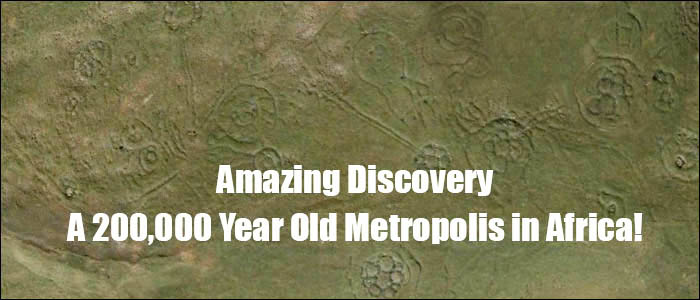
Ancient: Human Metropolis Found in Africa From 160,000 BC
Ancient Human Metropolis Found in Africa
By Dan Eden for viewzone.
They have always been there. People noticed them before. But no one could remember who made them — or why? Until just recently, no one even knew how many there were. Now they are everywhere — thousands — no, hundreds of thousands of them! And the story they tell is the most important story of humanity. But it’s one we might not be prepared to hear.
Something amazing has been discovered in an area of South Africa, about 150 miles inland, west of the port of Maputo. It is the remains of a huge metropolis that measures, in conservative estimates, about 1500 square miles. It’s part of an even larger community that is about 10,000 square miles and appears to have been constructed — are you ready — from 160,000 to 200,000 BCE!
The image [top of page] is a close-up view of just a few hundred meters of the landscape taken from google-earth. The region is somewhat remote and the “circles” have often been encountered by local farmers who assumed they were made by some indigenous people in the past. But, oddly, no one ever bothered to inquire about who could have made them or how old they were.
This changed when researcher and author, Michael Tellinger, teamed up with Johan Heine, a local fireman and pilot who had been looking at these ruins from his years flying over the region. Heine had the unique advantage to see the number and extent of these strange stone foundations and knew that their significance was not being appreciated.
“When Johan first introduced me to the ancient stone ruins of southern Africa, I had no idea of the incredible discoveries we would make in the year or two that followed. The photographs, artifacts and evidence we have accumulated points unquestionably to a lost and never-before-seen civilization that predates all others — not by just a few hundred years, or a few thousand years… but many thousands of years. These discoveries are so staggering that they will not be easily digested by the mainstream historical and archaeological fraternity, as we have already experienced. It will require a complete paradigm shift in how we view our human history. “ — Tellinger
Where it was found:

The area is significant for one striking thing — gold. “The thousands of ancient gold mines discovered over the past 500 years, points to a vanished civilization that lived and dug for gold in this part of the world for thousands of years,” says Tellinger. “And if this is in fact the cradle of humankind, we may be looking at the activities of the oldest civilization on Earth.”
To see the number and scope of these ruins, I suggest that you use google-earth and start with the following coordinates:
Carolina — 25 55′ 53.28″ S / 30 16′ 13.13″ E
Badplaas — 25 47′ 33.45″ S / 30 40′ 38.76″ E
Waterval — 25 38′ 07.82″ S / 30 21′ 18.79″ E
Machadodorp — 25 39′ 22.42″ S / 30 17′ 03.25″ E
Then perform a low flying search inside the area formed by this rectangle. Simply Amazing!
Did gold play some role in the dense population that once lived here? The site is just about 150 miles from an excellent port where maritime trade could have helped to support such a large population. But remember — we’re talking almost 200,000 years ago!
The individual ruins [see below] mostly consist of stone circles. Most have been buried in the sand and are only observable by satellite or aircraft. Some have been exposed when the changing climate has blown the sand away, revealing the walls and foundations.

“I see myself as a fairly open-minded chap but I will admit that it took me well over a year for the penny to drop, and for me to realise that we are actually dealing with the oldest structures ever built by humans on Earth. The main reason for this is that we have been taught that nothing of significance has ever come from southern Africa. That the powerful civilizations all emerged in Sumeria and Egypt and other places. We are told that until the settlement of the BANTU people from the north, which was supposed to have started sometime in the 12th century AD, this part of the world was filled by hunter gatherers and so-called Bushmen, who did not make any major contributions in technology or civilization.” — Tellinger
A Rich and Diverse History
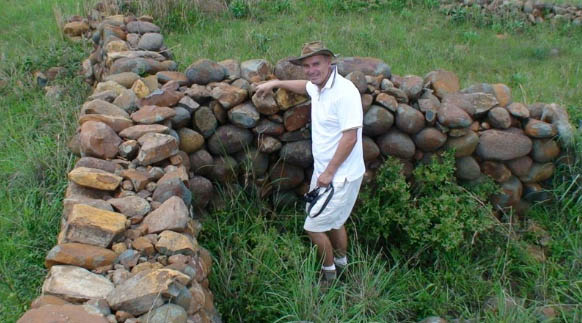
When explorers first encountered these ruins, they assumed that they were cattle corals made by nomadic tribes, like the Bantu people, as they moved south and settled the land from around the 13th century. There was no previous historical record of any older civilization capable of building such a densly populated community. Little effort was made to investigate the site because the scope of the ruins was not fully known.
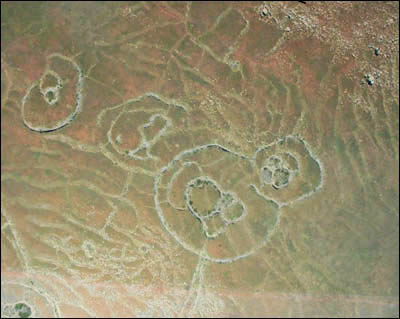
Over the past 20 years, people like Cyril Hromnik, Richard Wade, Johan Heine and a handful of others have discovered that these stone structures are not what the seem to be. In fact these are now believed to be the remains of ancient temples and astronomical observatories of lost ancient civilizations that stretch back for many thousands of years.
These circular ruins are spread over a huge area. They can only truly be appreciated from the air or through modern sattelite images. Many of them have almost completely eroded or have been covered by the movement of soil from farming and the weather. Some have survived well enough to reveal their great size [see above] with some original walls standing almost 5 feet high and over a meter wide in places.
Looking at the entire metropolis, it becomes obvious that this was a well planned community, developed by a highly evolved civilization. The number of ancient gold mines suggests the reason for the community being in this location. We find roads — some extending a hundred miles — that connected the community and terraced agriculture, closely resembling those found in the Inca settlements in Peru.
But one question begs for an answer — how could this be achieved by humans 200,000 years ago?
How the Site was dated
Once the ruins were examined, the researchers were anxious to place the lost civilization in a historical perspective. The rocks were covered with a patina that looked very old but there were no items sufficient for carbon-14 dating. It was then that a chance discovery revealed the age of the site, and sent a chill down the spine of archaeologists and historians!
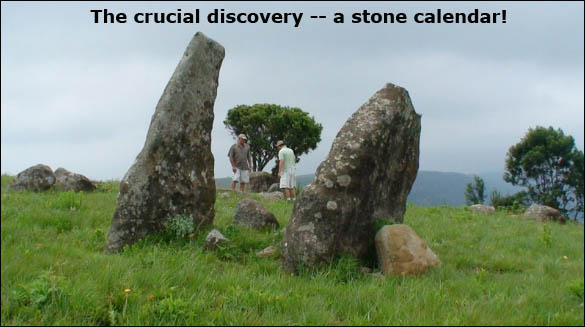
Dating the site:
Finding the remains of a large community, with as many as 200,000 people living and working together, was a major discovery in itself. But dating the site was a problem. The heavy patina on the rock walls suggested the structures were extremely old, but the science of dating patina is just being developed and is still controversial. Carbon-14 dating of such things as burnt wood introduces the possibility that the specimens could be from recent grass fires which are common in the area. The breakthrough came quite unexpectedly. As Tellinger describes it:
“Johan Heine discovered Adam’s Calendar in 2003, quite by accident. He was on route to find one of his pilots who crashed his plane on the edge of the cliff. Next to the crash site Johan noticed a very strange arrangement of large stones sticking out of the ground. While rescuing the injured pilot from about 20 metres down the side of the cliff, Johan walked over to the monoliths and immediately realised that they were aligned to the cardinal points of Earth — north, south, east and west. There were at least 3 monoliths aligned towards the sunrise, but on the west side of the aligned monoliths there was a mysterious hole in the ground — something was missing.After weeks and months of measuring and observations, Johan concluded that it was perfectly aligned with the rise and fall of the Sun. He determined the solstices and the equinoxes. But the mysterious hole in the ground remained a big puzzle. One day, while contemplating the reason for the hole, the local horse trail expert, Christo, came riding by. He quickly explained to Johan that there was a strange shaped stone which had been removed from the spot some time ago. Apparently it stood somewhere near the entrance to the nature reserve.
After an extensive search, Johan found the anthropomorphic (humanoid shape) stone. It was intact and proudly placed with a plaque stuck to it. It had been used by the Blue Swallow foundation to commemorate the opening of the Blue Swallow reserve in 1994. The irony is that it was removed from the most important ancient site found to date and mysteriously returned to the reserve — for slightly different reasons.
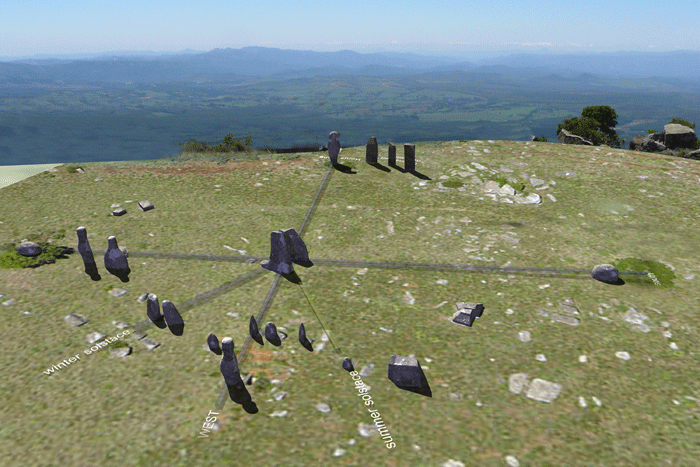
The exact location of the calendar is listed on http://www.makomati.com. The first calculations of the age of the calendar were made based on the rise of Orion, a constellation known for its three bright stars forming the “belt” of the mythical hunter.
The Earth wobbles on its axis and so the stars and constellations change their angle of presentation in the night sky on a cyclical basis. This rotation, called the precession completes a cycle about every 26,000 years. By determining when the three stars of Orion’s belt were positioned flat (horizontal) against the horizon, we can estimate the time when the three stones in the calendar were in alignment with these conspicuous stars.
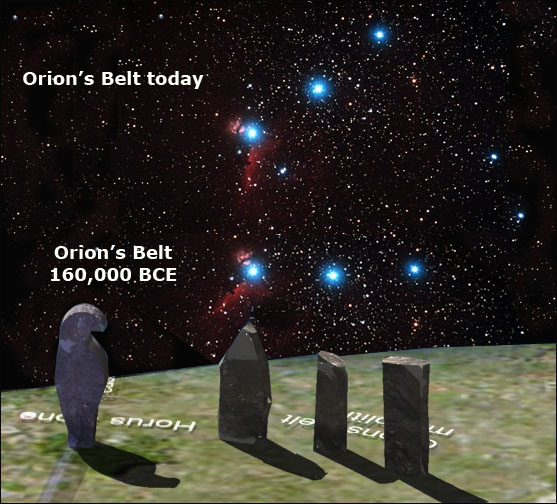
The first rough calculation was at least 25,000 years ago. But new and more precise measurements kept increasing the age. The next calculation was presented by a master archaeoastronomer who wishes to remain anonymous for fear of ridicule by the academic fraternity. His calculation was also based on the rise of Orion and suggested an age of at least 75,000 years. The most recent and most acurate calculation, done in June 2009, suggests an age of at least 160,000 years, based on the rise of Orion — flat on the horizon — but also on the erosion of dolerite stones found at the site.
Some pieces of the marker stones had been broken off and sat on the ground, exposed to natural erosion. When the pieces were put back together about 3 cm of stone had already been worn away. These calculation helped assess the age of the site by calculating the erosion rate of the dolerite.

Who made the metropolis? Why?
It would seem that humans have always valued gold. It is even mentioned in the Bible, describing the Garden of Eden’s rivers:Genesis 2:11 — The name of the first [river] is Pishon; it flows around the whole land of Havilah, where there is gold.
South Africa is known as the largest gold producing country of the world. The largest gold producing area of the world is Witwatersrand, the same region where the ancient metropolis is found. In fact nearby Johannesburg, one of the best known cities of South Africa, is also named “Egoli” which means the city of gold.
It seems highly probable that the ancient metropolis was established because of its proximity to the largest supply of gold on the planet. But why would ancient people work so hard to mine gold? You can’t eat it. It’s too soft to use for tool making. It isn’t really useful for anything except ornaments and its physical beauty is on a par with other metals like copper or silver. Exactly why was gold so important to early homo sapiens?
To explore the answer we need to look at the period of history in question — 160,000 to 200,000 years BCE — and learn what was happening on planet Earth.
What were humans like 160,000 years ago?Modern humans, homo sapiens, can trace our ancestry back through time to a point where our species evolved from other, more primitive, hominids. Scientists do not understand why this new type of human suddenly appeared, or how the change happened, but we can trace our genes back to a single female that is known as “Mitochondrial Eve”.
Mitochondrial Eve (mt-mrca) [Right: An artist's rendition]

is the name given by researchers to the woman who is defined as the matrilineal most recent common ancestor (MRCA) for all currently living humans. Passed down from mother to offspring, all mitochondrial DNA (mtDNA) in every living person is derived from this one female individual. Mitochondrial Eve is the female counterpart of Y-chromosomal Adam, the patrilineal most recent common ancestor, although they lived at different times.
Mitochondrial Eve is believed to have lived between 150,000 to 250,000 years BP, probably in East Africa, in the region of Tanzania and areas to the immediate south and west. Scientists speculate that she lived in a population of between perhaps 4000 to 5000 females capable of producing offspring at any given time. If other females had offspring with the evolutionary changes to their DNA we have no record of their survival. It appears that we are all descendants of this one human female.
Mitochondrial Eve would have been roughly contemporary with humans whose fossils have been found in Ethiopia near the Omo River and at Hertho. Mitochondrial Eve lived significantly earlier than the out of Africa migration which might have occurred some 60,000 to 95,000 years ago.

[right] The region in Africa where one can find the greatest level of mitochondrial diversity (green) and the region anthropologists postulated the most ancient division in the human population began to occur (light brown). The ancient metropolis in located in this latter (brown) region which also corresponds to the estimated age when the genetic changes suddenly happened.
Could this be a coincidence?
Ancient Sumerian history describes the ancient metropolis and its inhabitants!I’ll be honest with you. This next part of the story is difficult to write. It’s so shocking that the average person will not want to believe it. If you are like me, you’ll want to do the research yourself, then allow some time for the facts to settle in your mind.
We are often made to believe that the Egyptians — the Pharoahs and pyramids — are where our known history begins. The oldest dynasties go back some 3200 years BP. That’s a long time ago. But the Sumerian civilization, in what is now Iraq, is much older. What’s more, we have translated many of their history tablets, written in cuneiform and earlier scripts so we know a lot about their history and legends.
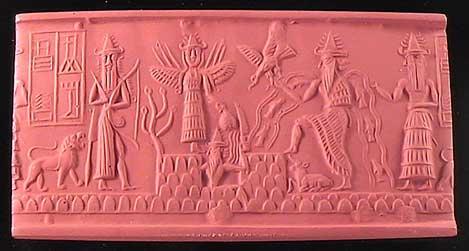
The seal image [above] depicts the legend of the “Great Flood” which consumed mankind. Many Sumerian legends are strikingly similar to Genesis. Like Genesis, the Sumerian legend, Atrahasis, tells the story of the creation of modern humans — not by a loving God — but by beings from another planet who needed “slave workers” to help them mine gold on their extra-planetary expedition!

